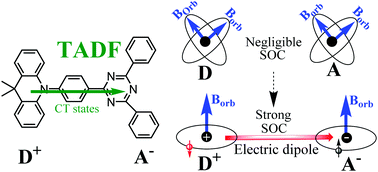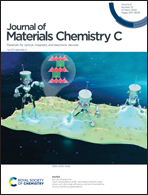Exploring mechanisms for generating spin-orbital coupling through donor–acceptor design to realize spin flipping in thermally activated delayed fluorescence†
Abstract
Spin flipping has recently been recognized as a critical mechanism to enable conversion from non-radiative triplets into radiative singlets, leading to thermally assisted delayed fluorescence (TADF) in organic light-emitting diodes (OLEDs). However, it is a controversial issue on how spin flipping is realized in the absence of heavy elements. This paper provides clear evidence to show that spin-orbital coupling (SOC) is indeed formed in charge-transfer (CT) states through donor–acceptor (D–A) design by using magneto-photoluminescence (magneto-PL), in both steady and dynamic states. Essentially, a magneto-PL signal is observed at a high field (up to 900 mT) only if the CT states are excited within D–A structures in a typical TADF emitter DMAC-TRZ in solutions. This provides unambiguous evidence to show the existence of SOC in TADF molecules where heavy elements are absent. An empirical model is proposed to show the SOC generated in CT states by considering orbital polarizations by optically induced dipoles (D+ → A−). Furthermore, SOC is confirmed to be responsible for realizing spin flipping by directly monitoring the delayed fluorescence while the density of non-radiative triplets is changed by oxygen molecules. More importantly, by using solvent polarity to change the dipole moment in CT states, it is revealed that SOC-induced spin flipping is largely changed, presenting a unified relationship between the SOC and the dipole moment to control the spin flipping enabling the conversion from non-radiative triplets into radiative singlets in TADF.



 Please wait while we load your content...
Please wait while we load your content...